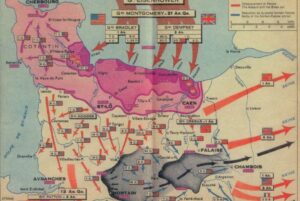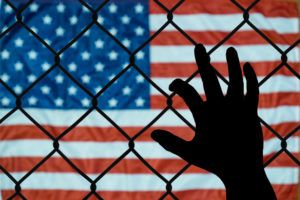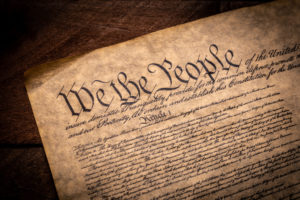
Today is the 80th anniversary of D-Day, the Allied invasion of Normandy, in northwestern France.
Germany had been economically reeling since the 1918 end of World War I, in large part because the European winners had ignored President Woodrow Wilson and forced Germany to pay huge reparations. This contributed to horrible inflation and economic distress in Germany, and the devastating crash of the American stock market in 1929 caused a worldwide depression that only worsened the German economy.
Adolf Hitler’s Nazi Party took advantage, eventually seizing complete power in 1933. As dictator, Hitler quickly expanded the German military and began throwing his weight around in Europe. In 1938, he forced a merger with Austria. Later that year, he took control of German parts of Czechoslovakia, and was very convincing to other European leaders that that was all he wanted.
But in 1939, he took over the rest of Czechoslovakia, and after cutting a deal with Russia, invaded Poland, and World War II had begun. Meanwhile, Hitler’s Axis partner Italy (under dictator Benito Mussolini) had attacked and invaded several countries including Yugoslavia, Syria, Ethiopia, and Somalia. The other Axis member, the Empire of Japan, had brutally attacked and occupied large parts of China, Vietnam and the Pacific.
Meanwhile the USA was still mainly anti-war and isolationist, considering Hitler and Mussolini a European problem and Japan an Asia problem. Our longtime ally Britain was fighting essentially alone, as Hitler’s troops overran France in 1940. Britain was pounded from the air repeatedly for two years. President Roosevelt did what he could to send supplies and equipment to our allies, including Russia, who Hitler had betrayed in June 1941. But still the American people wanted no part of a European war.
Finally, when the Japanese attacked our naval base at Pearl Harbor, Hawaii December 7, 1941, America woke up to the reality that distant dictators were our problem. Slowly but surely, the enormous might of the American economy converted to a wartime economy. Here in Minnesota, in less than six months, a huge bullet and artillery shell factory was bult in the northern Twin Cities suburbs, and the St. Paul Ford plant began making armored cars and aircraft components.
My father had joined the Minnesota National Guard in 1939, which was folded into the Army after Pearl Harbor. He was washed out of Flight School because at six foot-six, he was too tall (the original recruiter had winked at him when he told them he was 5’18”). He ended up in India and Burma, helping supply troops fighting the Japanese. My mother was a teenager, selling candy bars and snack to workers in the South St. Paul stockyards, who were packing meat for the war effort. She later talked about how everyone in this country helped the war effort. Gas and food were rationed, to make sure our forces had fuel and food. ‘Victory Gardens’ were planted in backyards to grow food. Silk stockings couldn’t be found (Nylon had just been invented) because it was all used for parachutes, so young girls would draw “seams” on the back of their calves, because it seemed scandalous to wear a dress with bare legs.
After Pearl Harbor, our armed forces were rapidly expanded and trained. From 1941 to 1944, our troops fought in the Pacific, in Africa and in Italy, but England and Russia had begged for an invasion of Western Europe. Russia was defending the Eastern front, the longest and bloodiest battleline in history, with 24 million solders and citizens killed by Hitler’s invaders. Almost all of Europe was conquered and under Hitler’s thumb.
Finally, the invasion preparations were finished, and on June 6, the weather almost cooperated. Operation Overlord, the largest seaborne invasion in history with almost 200,000 sailors carrying over 156,000 soldiers crossed the English Channel landing on five beaches in Normandy. Hitler had spent years fortifying against such an invasion, with artillery, concrete machine gun bunkers, facing the ocean. Strong winds blew many of the ships off course, and many American soldiers found themselves landing in areas off their battle maps.
Hitler had spent years fortifying against such an invasion, with artillery, concrete machine gun bunkers, facing the ocean. Strong winds blew many of the ships off course, and many American soldiers found themselves landing in areas off their battle maps.
Meanwhile, 24,000 airborne soldiers in gliders or from parachutes had started hours before dropping in behind the German fortifications to try to capture important locations, especially bridges.
None of the Allied objectives were achieved that day, as the Germans tried to slaughter the Allied soldiers on the beaches. There were over 19,000 casualties that day, but despite their losses, the Allied troops kept coming and over the following months, began the long march toward Hitler’s defeat, eleven months later.
the beaches. There were over 19,000 casualties that day, but despite their losses, the Allied troops kept coming and over the following months, began the long march toward Hitler’s defeat, eleven months later.
As the Allied forces marched east, they discovered the true evil of Hitler’s plan to eradicate the Jewish people and other so-called ‘undesirables.’ Similarly, the full scope of Japanese military atrocities in China and Korea were revealed.
There are many books and movies about D-Day, and I have written my thoughts about them. There are many fictionalizations of what would have happened if the Allies had faltered, if America had stayed out, if Britain had fallen, or if the brilliant German scientists had figured out the atomic bomb before we did. But the fascists were defeated, in great part by American troops and industry.
But there can be no doubt that those men and women, our parents and grandparents, who stood up and fought for freedom and liberty…simply saved the world.

As a partner with Bradshaw & Bryant, Joe Crumley has over 30 years experience helping injured people and their families to secure just and fair compensation. Excelling in personal injury litigation, Mr. Crumley has secured numerous record-setting verdicts and settlements and won accolades such as MTLA’s “Trial Lawyer of the Year” and “Excellence” Awards.











Comments for this article are closed.